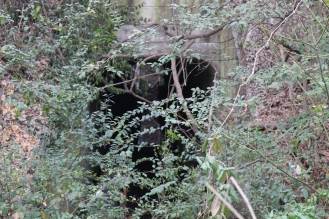
Columbia’s Rat Hole
In the curve where South High and Depot Streets meet, hidden behind a shield of scrubby trees and vines, is a forgotten Columbia landmark known simply as the “Rat Hole.”
The Rat Hole sits a stone’s throw away from Columbia’s Union Station Depot and the two share a common builder, the railroad. But, instead of saying these two constructions—the Depot and the Rat Hole—are siblings, it would probably be best to say they are first cousins, as the Depot was grandiose in its construction. The Rat Hole was one hundred percent utilitarian.
When construction of the Depot began in 1902, the railroad bed was raised about six feet above street level. This caused the city to close South High Street at the railroad tracks. Knowing that pedestrians would more than likely use the straightest route across the railroad tracks where South High used to be, the railroad decided to divert these pedestrians away from the tracks by constructing a tunnel underneath the rails, thus giving birth to the Rat Hole.
It’s not known when the tunnel was given the “Rat Hole” moniker, but the name seemed to catch on all over town. Generations of Columbians knew exactly where the Rat Hole was and a good number of them actually used it. The tunnel was frequented so often that lights were eventually installed for nighttime use.
As pedestrian traffic in the area of the Depot diminished, so did the usefulness of the Rat Hole. Today, the tunnel serves as a conduit for utility pipes. Upon latest inspection, the Rat Hole floor was filled with debris and at least a foot of water, making the tunnel impassable.
On your next trip to the Columbia Arts District, slow down as you make the curve between the Depot and the Columbia Arts Building. There in the brush you will see the opening of a tunnel. Only you will know that it is no ordinary tunnel—it is the forgotten landmark known as the Rat Hole.


